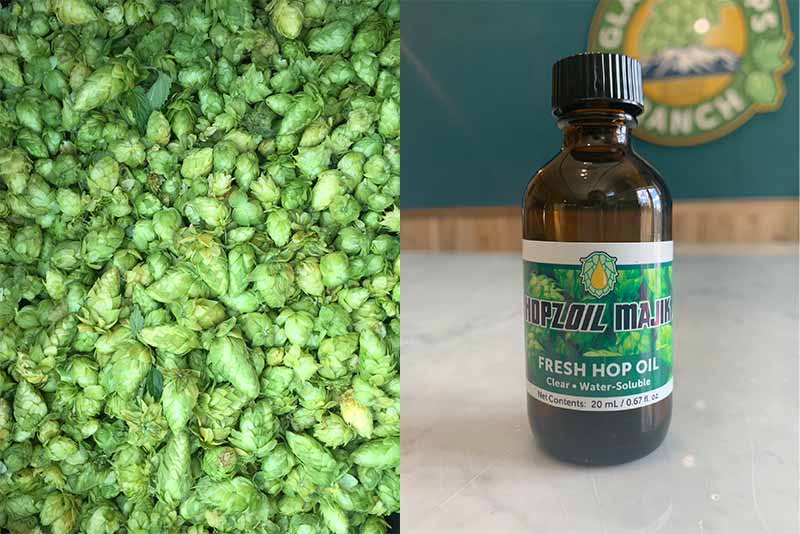
Not all liquid hop products are created equally. That’s why companies continue to pump out options for brewers to play around with. We’ve covered a lot of them, including John I. Haas’ SPECTRUM, INCOGNITO®, and Euphorics; Abstrax Quantum Series; Hopsteiner’s Salvo™; Freestyle Hops’ SubZero Hop Kief; Yakima Chief Hops’ DynaBoost; and Clayton Hops’ fresh-hop oil product Amplifire. The options have become endless, with brewers chomping at the bit to experiment with and add these products to their brewing arsenal. Another fresh-hop oil product from Glacier Hops Ranch, Hopzoil™, is gaining traction in craft beer circles.
We chatted with Glacier Hops Ranch Founder and CEO Tom Britz to learn more about Hopzoil, its origins and benefits, and how to use it. We also heard from Silver City Brewery Head Brewer Ian Campbell and retired veteran brewer Spike Buckowski, most recently of Terrapin Beer Company, who broke down how they use Hopzoil and in which beer styles it works best.
(Above photography courtesy of Glacier Hops Ranch)
Affordable, Industry-Leading Brewery Software
Glacier Hops Ranch Explains Hopzoil R&D
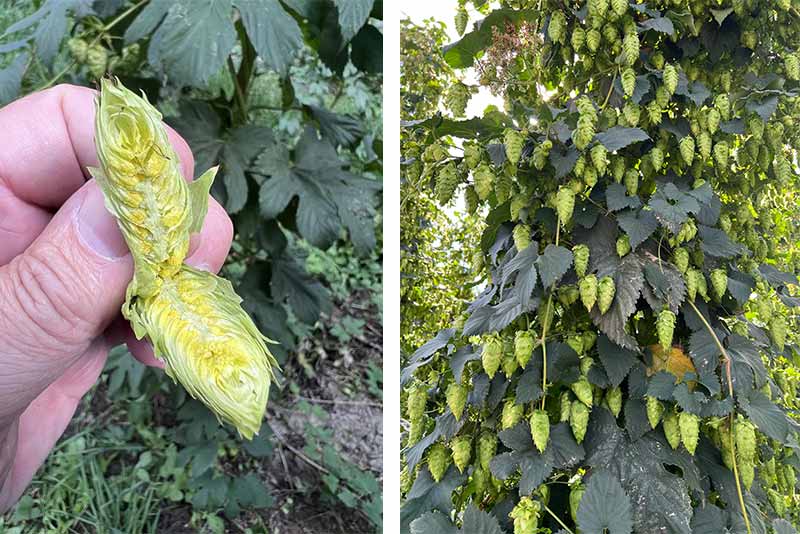
Photography courtesy of Glacier Hops Ranch
Hopzoil is a hop oil extract created by Glacier Hops Ranch. The extract comes right from fresh, wet hops during harvest time before the hops are dried and pelletized. Hopzoil, according to its webpage, captures all the aromatic and volatile oils of ripe hops—which typically evaporate off during the drying process—through steam distillation. Once distilled through a wholly steamed process, the oil is ready for use in beer. Britz explains how the whole process began in 2014.
The idea for Hopzoil actually started in 2014 when Britz heard about a new beer Sierra Nevada was launching, a beer called Hop Hunter IPA. The wet-hopped IPA used fresh steam-distilled hop oil.
Britz says that at the time, one of his early advisers, a county agriculture agent, asked him if Glacier Hops could use steam distillation for hops.
“I said, ‘No, that’s not how it’s done,’” explains Britz, noting that the area they’re in used to have a bunch of steam distilleries. “Everybody uses CO2 supercritical extraction.’”
But Britz says the question piqued his interest.
In 2015, the Glacier Hops team worked with the Montana State University Agriculture Research Center to develop a trial.
“They had a research distillery, which was very small-scale, and they offered to do a test distillation,” Britz says. “Honestly, I didn’t know if we could get any hop oil out of hops.”
But they extracted a “whopping” eight ounces of Cascade hop oil from fresh hops.
“We had no idea what to do with [it],” Britz remembers. “And so it took us probably the better part of a year to figure it all out.”
When Britz took the trial product to the Craft Brewers Conference in Philadelphia in the spring of 2016, he was shocked by brewers’ excited reactions. “It was so outrageous,” he says. “I’ll never forget that people were just going, ‘Wow.’ They couldn’t believe it.”
One of those brewers, Buckowski, remembers meeting Britz at the 2016 Craft Brewers Conference (CBC); he has been using the product ever since.
“We’ve been with them since day one,” Buckowski says.
After that CBC, Britz knew they had something on their hands. By the next harvest, Glacier Hops produced a couple of varieties and commercial quantities, dialing in their water solubility issues and dosing rates over the next year.
“They get stronger and better every year,” says Buckowski, who used Hopzoil in Terrapin’s Hopsecutioner IPA, which they dry hop with Cascade. “For me, it was how realistic the product was. I have tried others. They are OK, but I don’t get the same results.”
Within a few years, Britz introduced Hopzoil to international markets like South America, China, Australia, Europe, Mexico, and Canada, building up the product.
Similarly, Campbell says Silver City learned of Hopzoil in its early years.
In 2018, the Seattle-based brewery designed a double IPA recipe—Ripe and Juicy—around Hopzoil’s Azacca variation.
“We wanted to showcase the Hopzoil, so we introduced the Hopzoil at a pretty high rate,” explains Campbell. “We were trying to showcase a double IPA and reduce the loss.”
In 2020, with a retired chemist, Glacier Hops developed an all-natural, all-plant-based emulsion formulation of Hopzoil that created a consistent, stable product and earned a Good Manufacturing Practices certification.
Glacier Hops has four different varieties of Hopzoil: Pure, Majik, Hazy, and Powder.
The Pure is a steam-distilled essential oil from fresh hops that requires emulsification with ethanol or other agents to blend in beer or other beverages.
Majik is a concentrated, water-soluble emulsification designed to be dosed directly into a beverage. It contains all the flavor and aroma of Pure, but requires no ethanol to dose, and it extends shelf-life in beer up to five times longer than pellets.
Hazy is an opaque, water-soluble concentration designed for dosing directly into a beverage where hazy turbidity is the desired result.
And Powder is a new product coming soon, ideal for powdered supplements, capsules, tablets, and drink mixes.
Britz says Majik and Hazy are the ideal options for brewers, and each includes true-to-type hop varieties, as well as some blended options.
Currently, there are more than twenty Hopzoil hop choices.
What Are the Benefits of Hopzoil?

Photography courtesy of Glacier Hops Ranch
Campbell says the thing they like most about Hopzoil is that they know what they are getting.
“We can design a beer from the ground up based on what we like,” he says. “We know what it tastes like and can blend from there.”
Buckowski says staying true-to-type jumps out to him, especially compared to other products on the market.
“I just get a better, more natural flavor and aroma compound,” he says. “It’s always very bright and more natural.”
Britz points to several things, including the bright aromatics, but he says it’s really about saving the brewer money by increasing yield.
“We learned early on that when used as a dry hop partial substitute, brewers could make more money,” Britz says. “They could also increase their yield, increase the shelf life of the beer, reduce shipping.”
These benefits really stood out during the pandemic.
That’s when Hopzoil took off. Brewers wanted to make the best possible beer while adding to their bottom line.
“Today, what we hear [from brewers] is, ‘How can I squeeze more beer out of every batch?’ ‘How can I make more profit?’ ‘How can I make more revenue out of every batch?’ ‘What can I do to be more efficient?’ ‘What can I do to economize?’” says Britz.
Beyond that, both the Majik and Hazy forms of Hopzoil have documented data of increased shelf life.
According to Britz, Majik helped clear beers stay on the shelves for 270 days while the Hazy variation tested to 240 days. “It held up well,” he adds. “Everybody was pretty happy with the length it stores. “There is a gradual decline, but it doesn’t fall off a cliff like typical IPAs.”
Britz shared a spreadsheet showing how much yield savings Hopzoil can generate.
“One of the things that we learned from brewers is that for every pound of hops you use for dry hopping, you’re losing 6.8 to 7.5 percent of the yield,” Britz says. “For example, we took a brewery’s 15-bbl batch [of beer in the spreadsheet]. They’re using 18 pounds of hops, and we did a 100 percent replacement with 10 milliliters per barrel of Hopzoil, and they came up with a 9 percent yield savings.”
Britz adds, “So they’re picking up 1.35 additional barrels on this batch.”
Buckowski noted yield as a huge benefit at Terrapin.
“Depending on what beer we were brewing,” he says, “it looks like we yielded around eight to twelve percent increase in beer volume.”
What Is the Dosage Rate of Hopzoil?
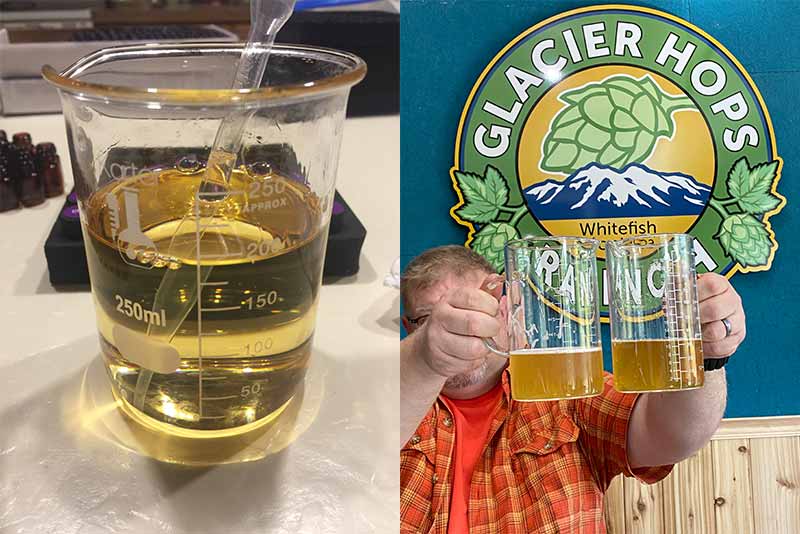
Photography courtesy of Glacier Hops Ranch
Start small and build up to the ideal dosage.
“We like to say with the dosing rates,” Britz says, “test small, fail small.”
Buckowski says that with any new product, he goes under and does it as a benchtop trial.
“I pull one hundred milliliters or a gallon of beer and go from there,” Buckowski says. “The tricky thing is that you don’t need a lot. We took half-barrel kegs and dosed it at intervals—one percent, two percent, three percent—and then decided on what we wanted.”
He adds, “The dosing rate we landed on was 2.5 to 3 milliliters per barrel, depending on what beer. Once we got where it was a match, we said this is our volume and what we’ll use.”
Glacier Hops developed a rule of thumb for dosing beer with Hopzoil. They suggest brewers reduce their pellets by fifty to seventy-five percent and replace them with approximately five milliliters per barrel of Hopzoil.
“Leave some of the pellets in because that grassy biomass adds something that can’t be replaced with just pure oil,” Britz says. “Five milliliters [of Hopzoil per barrel] is not very much. This stuff is super concentrated, and a little goes a long way.”
Buckowski said they have their own rule of thumb.
“I always cut it in half and gradually build up myself,” says Buckowski, adding that, to emulate Hopsecutioner with Hopzoil, they cut the Cascade dry hop pellets in half and used Hopzoil to fill in the rest. “It was pretty easy. It took a couple of days. Dose it, contact time, then taste it on a panel.”
Britz recommends beginning with benchtop trials, starting with a toothpick test into two to three ounces of beer, then going to a liter of beer and using a micropipette to understand the flavors you get from the Hopzoil.
“As you refine your recipe or formulation with a liter at a time,” Britz says, “you can scale it.”
Campbell says they dose on a range. For its Ripe and Juicy, they do a high rate of 9.5 milliliters per barrel. For a hazy with POG fruits, Ride the Spiral, they dose at a smaller rate—around .079 milliliters per barrel.
“[Those rates] give us a good hoppy bite to the beer,” Campbell says. “We produce these and get around ninety percent yield from the fermenter.”
When Do You Use Hopzoil in the Brew Process?
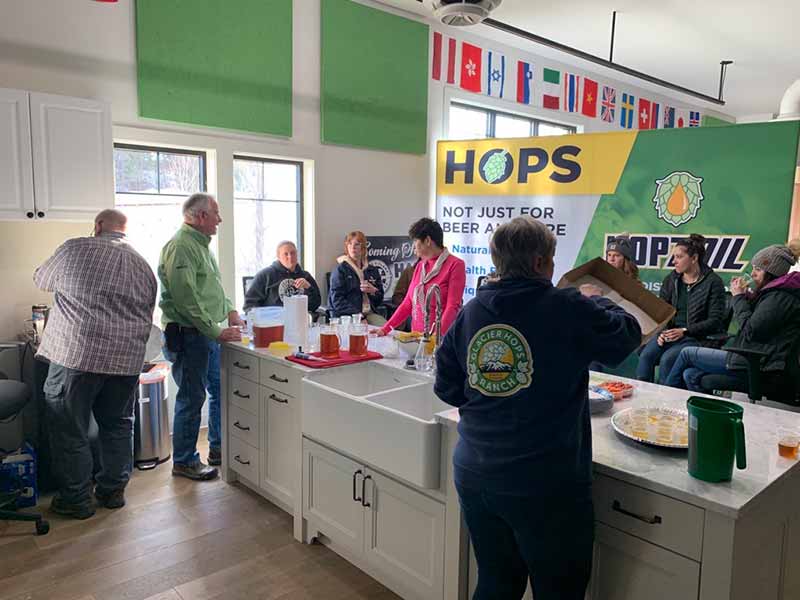
Photography courtesy of Glacier Hops Ranch
Once you figure out the dosage rate for your beer, you should infuse it inline into cold, finished beer, but before carbonation.
“You only use this on the cold side because the oils extracted during the steam distillation process, we get more of the volatile oils,” Britz says. “If you threw that into the boil—anything on the hot side—you’ll lose part of it.”
After the Hopzoil is in the beer, it must be agitated throughout.
“The emulsion, as it gets in and starts moving around, it definitely blooms for up to twenty-four hours,” Britz says. “If you taste it right after dosing, and then you taste it five minutes later, and then you taste it thirty minutes later, you’ll get subtle differences. … Most of the bloom is done after about an hour.”
Britz says trying this product with a new IPA is always best. When incorporating it into core or legacy beers, it becomes more of a challenge to match the flavor profile. But the main caution Britz warns is around when you inject the Hopzoil.
“You always carbonate last. If you carbonate after dosing, it has no impact on head retention whatsoever,” Britz says.
Silver City likes to dose through kegs.
“We have two separate dosing kegs,” Campbell says. “When we add fruit, we put [it] in there by weight, then add the Hopzoil.”
Campbell says inline is good, but they like to push it. He says they pump through a side port to a T, where they inject the Hopzoil solution, and then it all goes through the racking arm. They then cycle it through for a good twenty-five minutes.
“Our spec is to carb at 2.3 volumes, then dose, then ramp up the carbonation to 2.6 volumes,” Campbell says. “We make sure we taste and do sensory after, before packaging.”
Buckowski says they inject it post-filtration into the brite tank before carbonation.
“We send it inline through a mini keg,” Buckowski says. “And get a good dose on the way over.”
How Much Cost Savings Does Hopzoil Bring?
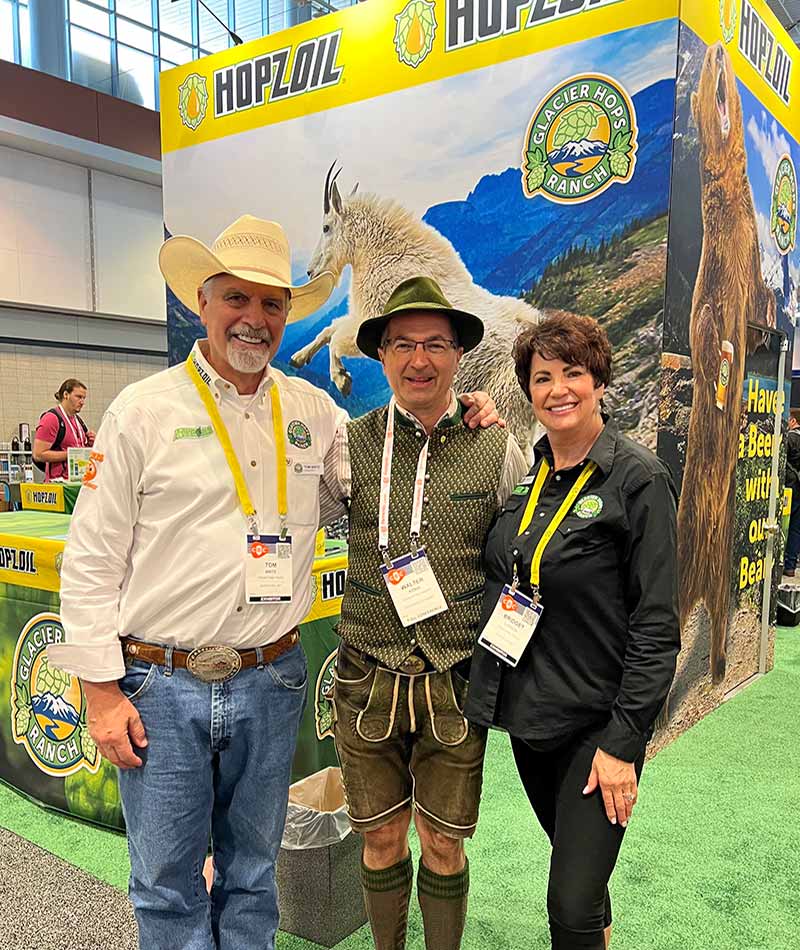
Photography courtesy of Glacier Hops Ranch
Based on the example referenced in the previous section, Britz explains that the brewery from the spreadsheet charged eight dollars per pint and picked up an additional 240 servings of beer through the increased yield.
“This is costing them more for Hopzoil [than T-90 hops], but they gain on taproom sales,” Britz notes. “So at the end of the day, the net gain is $2,300 per batch.”
He adds, “They’re doing twelve batches a year of this particular beer, so it’s adding $28,000 to the bottom line.”
Campbell reiterates how Silver City gets around ninety percent yield on their double IPAs, which is “pretty dang good,” he says. “More beer in the brite and more in the package is more money.”
Campbell says they are getting an additional 1.2 barrels of beer.
“You gain about $500 in sales with the increased yield,” Campbell says, noting that when you get less, you end up “brewing more, paying people to brew, et cetera.”
He adds, “It’s always better to invest in higher-quality, punchier stuff to get more beer out.”
Buckowski says the yield savings definitely correlate with an increase in revenue.
“We did save money,” he says. “Depending on the beer, our profits were around five to seven percent more.”
Which Style of Beer Works Best with Hopzoil?
Britz says Hopzoil can really impact any beer style.
“One of the things that we found is that this will change any kind of beer,” he says, from porters and stouts to double IPAs. “But depending on the brewer’s objectives, I think the best thing is to consult with us first to talk it through.”
Buckowski and Campbell both say IPA. Buckowski admits Hopzoil could work in a light lager, though he has yet to try that. He still believes using Hopzoil in an IPA will lend a more natural taste. But he advises to use it on a one-off product for best results.
“Because you are using the most hops in those beers,” Buckowski says. “Once you blend hops in an IPA and add Hopzoil, it really complements.”
Britz suggests using Hopzoil for hop notes in pilsners and lagers for which you “want market differentiation.”
For the most part, though, Britz says that any style with a lot of hops “is kind of a no-brainer because the economics, the efficiencies, the cost savings, and increased revenue is real obvious.”



